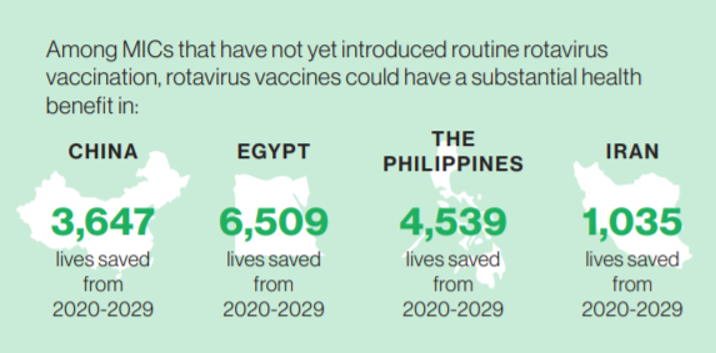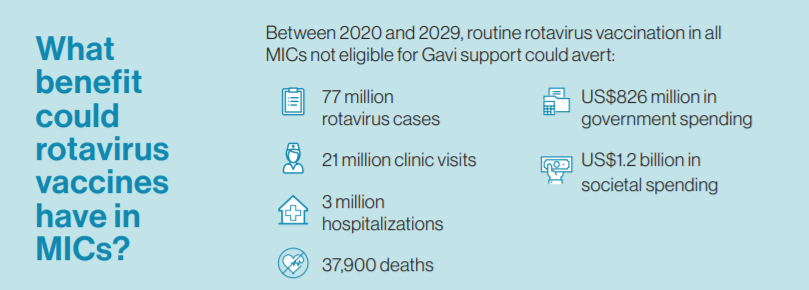
Newer rotavirus vaccines offer advantages for middle-income countries

Rotavirus vaccines are the best way to prevent illness caused by rotavirus, the most common cause of severe and fatal diarrhea in children under 5 years of age. Since 2006, over 110 countries have introduced rotavirus vaccines in their national immunization programs. Many of the initial introductions were in high-income countries. Thankfully, several low-income countries have also introduced rotavirus vaccines due to support from Gavi, the Vaccine Alliance. Because low-income countries often face the biggest health burden due to rotavirus diarrhea, this support has saved hundreds of thousands of children’s lives.
But another group of countries has lagged behind. Today, the biggest group of countries that have yet to introduce rotavirus vaccines are middle-income countries (MICs) not eligible for Gavi support. Of the 63 non-Gavi MICs, only 30 have introduced rotavirus vaccines. These countries often have a moderate rotavirus disease burden and constrained budgets, but since they do not often receive international funding support, the cost of rotavirus vaccines may be a major hurdle to introduction. Additionally, many of these countries may lack disease surveillance, so the extent of the rotavirus disease burden may be unknown or underappreciated.
Thankfully, in the last 3 years, the rotavirus vaccine landscape has changed substantially. Two lower-cost rotavirus vaccines are now available. Enhanced data on costs and disease burden from other countries also allow for more accurate modeling of rotavirus disease burden, rotavirus vaccine health benefits, and costs. Using this new data, PATH conducted an economic analysis to predict the 2020-2029 impact, cost-effectiveness, and benefit-risk ratio of the currently available rotavirus vaccines for 63 MICs ineligible for Gavi support. The results, summarized in a new infographic, are very encouraging for MICs. I spoke with PATH senior health economist Fred Debellut to learn more.
Laura: Why did you focus this study on non-Gavi MICs?
Fred: Non-Gavi MICs have not introduced rotavirus vaccines to the same extent that Gavi-supported lower-income countries and high-income countries have, and we feel that they are missing out on a lifesaving intervention. MICs often receive less attention from international aid groups, and with the newly available rotavirus vaccines plus the data and modeling tools that we have, we wanted to help inform these country decision-makers about rotavirus vaccine introduction with updated estimates.
Laura: So, what did you find? How would rotavirus vaccines benefit MICs?
Fred: We found that rotavirus vaccines would have a substantial benefit in the 63 non-Gavi MICs we included in the analysis. By using rotavirus vaccines from 2020 to 2029, these countries could prevent 77 million rotavirus cases, 3 million hospitalizations, and 37,900 deaths in children under 5 years of age. These benefits would be particularly pronounced in four countries: China, Egypt, the Philippines, and Iran. None of these countries has introduced rotavirus vaccines.

Laura: What about the cost?
Fred: Because of the availability of lower-cost vaccines, rotavirus vaccination is now much more affordable, even for resource-constrained MICs that do not qualify for Gavi support. Our analysis conservatively estimates that rotavirus vaccination would be cost-effective in at least 77% of MICs, including 21 of the 33 MICs not yet using rotavirus vaccines. While all available rotavirus vaccines would be cost-effective, ROTAVAC and ROTASIIL—which were both WHO-prequalified in 2018—were more affordable than ROTARIX.

Laura: So, should MICs introduce rotavirus vaccines?
Fred: Based on our analysis, rotavirus vaccination programs would be a good investment in at least three-fourths of non-Gavi MICs. They could save lives and prevent illness, medical care costs, and time lost to treatment. Any country that is considering introducing rotavirus vaccines and would like more information about projected benefits and costs should reach out to our team at HEOR@path.org.


